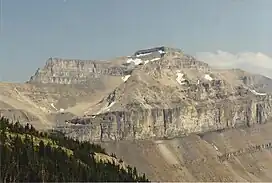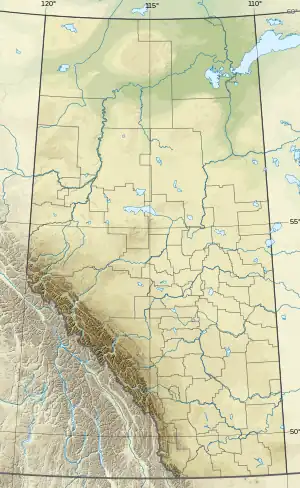Redoubt Mountain
Redoubt Mountain (alternatively Mount Redoubt) is a mountain located in Banff National Park, in the Canadian Rockies of Alberta, Canada. It forms the southern buttress of Boulder Pass.
| Redoubt Mountain | |
|---|---|
 Redoubt Mountain, August 1994. Viewpoint from Hidden Lake. | |
| Highest point | |
| Elevation | 2,902 m (9,521 ft)[1][2] |
| Prominence | 570 m (1,870 ft)[3] |
| Parent peak | Mount Richardson (3086 m)[3] |
| Listing | Mountains of Alberta |
| Coordinates | 51°28′02″N 116°04′52″W[4] |
| Geography | |
 Redoubt Mountain  Redoubt Mountain Redoubt Mountain (Canada) | |
| Parent range | Slate Range |
| Topo map | NTS 82N8 Lake Louise[4] |
| Geology | |
| Age of rock | Cambrian |
| Type of rock | Sedimentary |
| Climbing | |
| First ascent | 1906[3] |
| Easiest route | moderate/difficult scramble |
The mountain was named in 1908 by Arthur O. Wheeler, founding member of the Alpine Club of Canada (AAC), as it resembled a redoubt (an outer military defense).[1]
The mountain can be climbed on a moderate to difficult scrambling route on the northwestern ridge.[5]
Like other mountains in Banff Park, it is composed of sedimentary rock laid down from the Precambrian to Jurassic periods.[6] Formed in shallow seas, this sedimentary rock was pushed east and over the top of younger rock during the Laramide orogeny.[7]
Based on the Köppen climate classification, the mountain is located in a subarctic climate with cold, snowy winters, and mild summers.[8] Temperatures can drop below -20 °C with wind chill factors below -30 °C.
Gallery
References
- "Redoubt Mountain". cdnrockiesdatabases.ca. Retrieved 2007-08-31.
- Lake Louise & Yoho (Map). 1:50,000. Cochrane, AB: Gem Trek Publishing. 2001. § B5. ISBN 1-895526-15-9. Retrieved 2019-06-11.
- "Redoubt Mountain". Bivouac.com. Retrieved 2009-01-02.
- "Mount Richardson". Geographical Names Data Base. Natural Resources Canada. Retrieved 2019-10-09.
- Kane, Alan (1999). "Mount Redoubt". Scrambles in the Canadian Rockies. Calgary: Rocky Mountain Books. p. 255. ISBN 0-921102-67-4.
- Belyea, Helen R. (1960). The Story of the Mountains in Banff National Park (PDF). parkscanadahistory.com (Report). Ottawa: Geological Survey of Canada. Archived (PDF) from the original on 2015-10-02. Retrieved 2019-09-13.
- Gadd, Ben (2008), Geology of the Rocky Mountains and Columbias
- Peel, M. C.; Finlayson, B. L. & McMahon, T. A. (2007). "Updated world map of the Köppen−Geiger climate classification". Hydrol. Earth Syst. Sci. 11: 1633–1644. ISSN 1027-5606.

